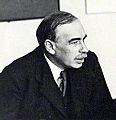World War I reparations facts for kids
World War I reparations were payments and valuable items that Germany had to give to other countries after losing World War I.
After the war, the Treaty of Versailles was signed. In this treaty, Article 231, also known as the 'war guilt' clause, said that Germany and its allies were responsible for all the damage and losses suffered by the countries they fought against. This set the stage for Germany to pay reparations.
In January 1921, a group called the Inter-Allied Reparations Commission decided the total amount Germany owed. It was set at 132 billion gold marks. This was a huge amount of money, about £6.6 billion or $33 billion at the time. Many economists thought this sum was far too high. Later that year, the amount was confirmed, but it still seemed impossible for most Germans to pay, both because of the size of the payment and the rules around it.
Germany stopped paying these reparations in 1933, when Adolf Hitler and his Nazi Party took control. By then, Germany had only paid about one-eighth of the total amount. The very last payments were made exactly 20 years after German reunification.
Contents
How Reparations Changed Over Time
There was a lot of debate about whether the reparations were fair and what impact they would have. For example, John Maynard Keynes, a British economist, quit his job in 1919 to protest how much money was being demanded from Germany.
In 1924, a new plan called the Dawes Plan changed how Germany's reparation payments worked. Then, in May 1929, the Young Plan reduced the payments even more. The new total was 112 billion gold marks, to be paid over 59 years until 1988. The Young Plan also split the yearly payment into two parts: one part that could not be delayed, and another part that could be postponed if needed.
Because of the Great Depression, a worldwide economic crisis, there was an attempt to delay further payments. This attempt failed, but at the Lausanne Conference of 1932, it was decided to cancel most of the remaining reparations. By this point, Germany had paid about one-eighth of what was originally asked for in the Treaty of Versailles. However, Germany completely refused to continue paying once Hitler came to power.
What Germans Thought
Most German people did not believe they had truly lost the war. The German military leaders often blamed civilians, especially socialists, communists, and Jews, for the defeat. This idea was known as the Dolchstoßlegende, or "stab-in-the-back myth." Germans were very unhappy with the large amount of reparations, partly because their leaders were not allowed to be part of the decision-making process.
How Reparations Affected Germany's Economy
Some people believe that the economic problems caused by the reparations were a big reason why the Weimar Republic (Germany's government after WWI) failed and why Adolf Hitler's dictatorship began. John Maynard Keynes, the British economist, thought that these payments would weaken Germany's economy and its political system. However, many historians disagree with him.
For example, Margaret MacMillan, a Canadian historian, believes that Germany could have paid all the reparations if they had truly wanted to. She argued that Germany simply did not want to pay.
Sally Marks, an American historian, also thought Germany could afford the payments. She pointed out that Germany paid the reparations fully and on time as long as French troops were in Düsseldorf in 1921. But they stopped paying after the French left in 1922. Later that year, the situation got worse. French and Belgian leaders wanted to occupy the Ruhr Area to force Germany to pay, while the British wanted to lower the payments. The occupation of the Ruhr began in January 1923. The Allies were quite sure that the German government was refusing to pay to see if the Allies would actually enforce the reparations.
As a "quiet fight" in the Ruhr, the German government caused hyperinflation, which destroyed the German economy in 1923. In 2008, British historian Richard J. Evans said that the German government was responsible for this hyperinflation because they preferred it to paying reparations. This made the world feel sorry for Germany, and the French were forced to agree to the Dawes Plan in April 1924, which lowered the reparations. Under this new plan, Germany paid 1 billion marks in 1924 and reached 2.25 billion by 1927. After that, Germany was supposed to pay 2.5 billion marks per year. However, the Germans still kept stopping their payments. To deal with this, the Allies met in London in July-August 1924. This was the first time Germany openly challenged the Treaty of Versailles.
The Germans complained that payments under the Dawes Plan were still too high. So, the Young Plan was created in 1928. This plan meant Germans would not have to pay more than 2.5 billion marks until 1988. Germany's foreign minister, Gustav Stresemann, demanded that the Rhineland (a German region occupied by Allied troops) be returned to Germany if they were to accept the plan. Under strong pressure, the French left the Rhineland in June 1930.
The British historian A. J. P. Taylor wrote that the reparations were harsh enough to feel like a punishment, but not harsh enough to stop Germany from becoming a great power again. He also suggested they played a part in the rise of Adolf Hitler.
Images for kids
-
Demonstration against the Treaty of Versailles, in front of the Reichstag.
-
Protests by gymnasts from the Ruhr at the 1923 Munich Gymnastics Festival. The sign on the left reads "The Ruhr remains German". The right placard reads "We never want to be vassals".
See also
 In Spanish: Reparaciones de la Primera Guerra Mundial para niños
In Spanish: Reparaciones de la Primera Guerra Mundial para niños







